Summary Data Quality Report
Att14 SDQReportACBS.docx
Behavioral Risk Factor Surveillance System (BRFSS) Asthma Call-back Survey (ACBS)
Summary Data Quality Report
OMB: 0920-1204
Attachment 14 –

2013
Behavioral Risk Factor Surveillance System
Asthma Call-Back Survey
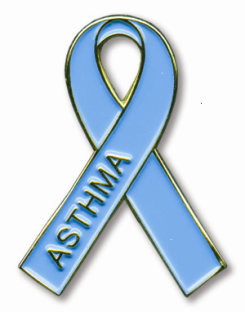
National
Asthma
Control
Program
Version 1.0.0
ACKNOWLEDGEMENT
The Asthma call-back Survey (ACBS) is funded by the National Asthma Control Program (NACP) in the Air Pollution and Respiratory Health Branch of the National Center for Environmental Health (NCEH). The ACBS is jointly administered with the National Center for Chronic Disease Prevention and Health Promotion (NCCDPHP), Division of Population Health (DPH).
NCEH and NCCDPHP greatly appreciate the efforts of the BRFSS staff in each ACBS participating state.
Paul Garbe, DVM, MPH
Chief, Air Pollution and Respiratory Health Branch
Division of Environmental Hazards and Health Effects
National Center for Environmental Health, CDC
MS F-60
4770 Buford Highway
Atlanta GA 30341
Phone: (770) 488-3700
Fax: (770) 488-1540
E-mail: [email protected]
Machell G. Town, Ph.D.
Acting Branch Chief, Population Health Surveillance Branch
Division of Population Health
National Center for Chronic Disease Prevention and Health Promotion
Centers for Disease Control and Prevention
1600 Clifton Road NE Mail Stop E97
Atlanta, GA 30333 USA
Phone: (404) 498 - 0503
Fax: (404) 498 - 0585
E-mail: [email protected]
2013 Asthma Call-Back Survey (ACBS) Summary Data Quality Report
Introduction
Procedures for interview disposition and response rates for the BRFSS Asthma Call-Back Survey (ACBS) follow usual BRFSS procedures; however, some additions and adaptations are required for the call-back survey. Disposition codes, disposition code categories, and response rates are discussed in the sections below. Figure one is a flow chart describing the eligibility paths BRFSS respondents with asthma follow through the ACBS process.
Because asthma characteristics vary by season, a seasonal analysis must take into account any state for which interviewing was not conducted throughout the year. States may have interrupted interviewing due to contract interruptions with their data collection company. In addition, some ACBS interviews are finalized in the first few months of the next calendar year. If a state is missing 6 or more consecutive months of child or adult data or has less than 6 complete months of child or adult data, the data from that state are not considered sufficiently comparable to the data from other states and are excluded from the public release file and the response rate calculations. If a state has fewer than 75 complete child interviews, reliable weights cannot be calculated and the child data from that state is excluded from the public release file.
Appendix A includes tables showing disposition code categories, response rates and interviews by month for each state participating in the ACBS each year. Appendix B includes information on the conversion from 3-digit to 4-digit disposition codes. Appendix C includes additional instruction on assigning the ACBS specific disposition codes. Detail on BRFSS response rates and procedures can be found in the BRFSS Data Quality Report Handbook and the BRFSS Summary Data Quality Report for each survey year (http://www.cdc.gov/brfss/annual_data/annual_data.htm).
Disposition Codes
The BRFSS disposition codes are used for the ACBS. However, a few additional codes are needed to account for situations specific to a call-back survey. In the list below, disposition codes added for the ACBS are underlined and bolded. There is no equivalent BRFSS code for ACBS specific codes. Detailed descriptions of the ACBS codes can be found in Appendix C.
The ACBS 4-digit disposition codes for 2013 are:
I. Eligible, contacted: complete interview
1100 Complete
1200 Partial complete (through the end of section 8)
II. Eligible, contacted: refusal or termination
4413 Refused to participate in the call-back during the BRFSS interview
2112 Refused to begin the ACBS interview after contacted
2120 Terminated within the questionnaire during the ACBS interview (before Section 9)
2211 Refused to allow combining ACBS responses with BRFSS responses
2212 Refused to answer the “ever had asthma” question during the ACBS interview
III. Eligible, lost to follow-up because unable to contact or communicate with the BRFSS respondent with asthma
2111 Hang up or termination before respondent contacted. Household contacted but ACBS respondent not contacted
2210 Selected respondent never reached or reached but did not begin interview during interviewing period. Selected respondent away from residence during the entire interviewing period.
2220 Telephone answering device, message confirming private residential status. Telecommunication technological barrier, message confirming private residential status
2320 Selected respondent physically or mentally unable to complete an interview during the entire interviewing period interviewing period
2330 Language problem after respondent selection
3100 Contact, hang-up or termination, unknown if private residence
3130 No answer
3140 Telephone answering device, unknown if private residence
3200 Hang-up or termination, known household. Household contact, eligibility undetermined
3322 Physical or mental impairment
3330 Language problem
4100 Household members away from residence during entire interviewing period
4900 Miscellaneous, non-eligible (for ACBS miscellaneous non-contact)
4306 Selected ACBS respondent no longer living in the BRFSS household
Temporary codes: should be resolved prior to submission
5050 Hang-up, unknown if housing unit
5100 Appointment
5111 Household level refusal
5112 Refusal: hang-up or termination
5120 Break off/ termination in questionnaire before Section 9
5130 No answer
5140 Answering machine, unknown if private residence
5220 Answering machine, message confirming residential status
5320 Physical or mental impairment
5330 Language problem
5550 Busy
5560 Unsafe location for interview
IV. Eligible, lost to follow-up for technical reasons
3150 Telecommunication technological barrier, unknown if private residence
3700 On never call list
4200 Dedicated fax/data/modem line with no human contact
4300 Telephone number no longer in service or changed. Non-working/disconnected number.
4400 Busy/Fast busy/Circuit busy
4430 Call forwarding/ pager
4450 Cellular telephone from landline sample
4460 Cell phone sample number connects to landline
4470 Cell phone respondent also has landline, less than 90% of all calls on cell phone.
4500 Not a private residence – business
4510 Not a private residence - group home
Temporary codes: should be resolved prior to submission
5150 Technological barrier other than answering machine, unknown if private residence
5200 Fax/data/modem
5300 Phone number temporarily out of service. Possible non-working number
5400 Technological barrier other than answering machine with message confirming residential status. Fast busy. Circuit busy
5599 Mistaken Ctrl-End
5700 Supervisor attention needed
5900 Null attempt
9999 Missing disposition code
V. Ineligible: all codes specific to ACBS (no BRFSS equivalent)
2290 Most knowledgeable person is not parent or guardian
2291 No parent or legal guardian in the household (child ineligible)
4480 Not recruited for call-back at BRFSS interview (excluded by state)
4490 Random child/adult selection: adult ineligible, child selected
4491 Random child/adult selection: child ineligible, adult selected
4405 Out-of-state when ACBS records are not transferred to state of residence
4700 Household, no eligible respondent (respondent does not have asthma)
4411 Selected respondent not eligible for follow-up
4412 Transferred from BRFSS but not attempted (excluded by state)
4471 Misdiagnosed asthma in respondent
Definitions and Labels for Disposition Code Categories
Because the ACBS is a call-back interview, all those identified with asthma at the BRFSS interview asthma are, with a few notable exceptions, eligible for the call-back survey. The ACBS eligibility flow chart (Figure 1) summarizes how BRFSS respondents are categorized for ACBS response rate calculation.
ACBS interviews are considered complete (COIN) if the respondents finish the entire interview or if they complete through section 8 of the ACBS interview. ACBS interviews are refusals if the respondent refuses participation at either the BRFSS interview or at the time of the ACBS interview. Terminations are ACBS interviews that start but are terminated during the interview before completing section 8.
The disposition codes that relate to contact problems or technology issues are considered “eligible, but lost to follow-up.” If they had been contacted, a small proportion of those eligible but lost to follow-up might actually be ineligible. All temporary disposition codes (numbered 5000 or higher) that should have been resolved but were not are treated as comparable 4000 level codes.
BRFSS respondents with asthma who are considered ineligible for the ACBS include those who are not asked to participate at the time of the BRFSS interview. Each year between 10% and 15% of those technically eligible are not asked to participate in the call-back survey. Respondents might not be asked for several reasons:
States with split samples may only include respondents in the call-back if they are in specified splits of the BRFSS sample. Counts for states that exclude split-sample respondents are excluded from the following tables and rate calculations.
The BRFSS respondent may partially complete the BRFSS interview but terminate before the call-back request.
Specific state BRFSS call-back contracts may limit the number of call-back interviews due to budgetary constraints.
States may stop conducting call-back interviews during contract negotiations.
BRFSS respondents with asthma who are asked to participate in the ACBS but are later classified as ineligible include:
Respondents in households where both the selected adult and selected child in the household have asthma. When both have asthma, only one is eligible for the ACBS.
Respondents who move out-of-state between the BRFSS interview and the ACBS interview in states that are not transferring ACBS interview or to/from states not participating in the ACBS.
Respondents who indicate, at the time of the ACBS interview, that the reported diagnosis of asthma was an error
Child respondents for whom the adult BRFSS respondent is not the child’s parent or guardian
Some respondents in states that have reached a pre-specified quota for ACBS interviews
The following table indicates how disposition codes are grouped into response rate categories shown in the eligibility flow chart (Figure 1):
Category |
Disposition Codes |
Notes |
Eligible COIN Completed interview |
1100, 1200 |
Through section 8 |
Eligible TERE Terminations and refusals |
4413 |
At BRFSS interview |
2112, 2120, 2211, 2212, |
At ACBS |
|
Eligible, lost to follow-up Not interviewed |
2111, 2210, 2220, 2320, 2330, 3100, 3130, 3140, 3200, 3322, 3330, 4100, 4900, 4306, 5050, 5100, 5111, 5112, 5120, 5130, 5140, 5220, 5320, 5330, 5550, 5560 |
Unable to contact or communicate with eligible respondent |
3150, 3700, 4200, 4300, 4400, 4430, 4450, 4460, 4470, 4500, 4510, 5400, 5150, 5200, 5300, 5599, 5700, 5900, 9999 |
Technical problems |
|
Ineligible |
2290, 2291, 4480, 4490, 4491 |
At BRFSS interview |
4405, 4700, 4411, 4471 |
At ACBS |
|
4412 |
No ACBS attempt |
Figure 1: ACBS Eligibility Flow Chart:
BRFSS
respondent with asthma ASTHMA3
= 1 (Yes)
Ineligible for call-back:
If
adult, child selected for call-back: code 4490 If
child, adult selected for call-back: code 4491 If
child, no parent/guardian:
codes 2290, 2291
Respondent
called for ACBS interview
Permission
granted
Ineligible for call-back Moved
out of state: code 4405 Does
not have asthma:
codes
4471, 4700 Other:
code 4411
Ineligible for call-back Never
called: code 4412
Recruited
for call-back
Asked permission question
Ineligible for call-back: code 4480 Split
sample
Quota Skipped
permission question
BRFSS TERE: refusal Permission
denied: code 4413

















ACBS COIN
Complete:
code 1100 Partial
complete: code 1200
Lost to follow-up Contact/communication
codes Technical
problem codes
ACBS TERE Termination:
code 2120 Refusal:
codes 2112, 2211, 2212





ACBS Response Rates
The ACBS Interview Completion Rate is the proportion of completed interviews among eligible respondents who are actually contacted for and started the ACBS interview. Those who refuse at the initial BRFSS interview (4413), those ineligible, and those never contacted are excluded from the denominator. This rate is based on actual contacts with the eligible respondent at the time of the call-back interview. The numerator of the rate includes completed interviews (COIN). The denominator of the rate includes completed interviews (COIN) plus the number contacted later for the ACBS interview who refuse or terminate the interview (disposition codes 2112, 2120, 2211, and 2212).
The ACBS Cooperation Rate is the proportion of completed interviews among all eligible respondents who are recruited and actually contacted for the ACBS interview. Eligible respondents who refuse the call-back at the time of the BRFSS interview are included. Non-contacts are excluded from the denominator, but contacts with communication problems specific to the respondent with asthma are included. The numerator of the rate includes completed interviews (COIN). The denominator of the rate includes completed interviews (COIN) plus refusals and terminations (TERE) plus the number of non-interviews that involved language problems with the respondent with asthma (2330) or physical/mental impairment of the respondent with asthma (2320). A Cooperation Rate below 65 percent may indicate some problem with interviewing techniques
The Refusal Rate is the percentage of all eligible respondents that refuse to be interviewed or terminate an interview early in the questionnaire. The numerator includes terminations and refusals (TERE). The denominator is the same as for the CASRO rate (below). The denominator includes completed interviews (COIN), terminations and refusals (TERE), and a proportion of those eligible but lost to follow-up. The proportion represents an estimate of the number of those lost to follow-up who would be expected to remain eligible if they had been contacted. The proportion of cases lost to follow-up that are estimated to be eligible is the same as the proportion of cases not lost to follow-up that are eligible. A Refusal Rate above 35 percent indicates some problem with interviewing techniques.
The Council of American Survey Research Organizations (CASRO) rate is a measure of respondent cooperation and is generally defined as the proportion of all eligible respondents in the sample for whom an interview has been completed. The numerator of the CASRO rate includes completed interviews (COIN). The denominator includes completed interviews (COIN), terminations and refusals (TERE), and a proportion of those eligible, but lost to follow-up. The proportion represents an estimate of the number of those lost to follow-up who would be expected to remain eligible if they had been contacted. The proportion of cases lost to follow-up that are estimated to be eligible is the same as the proportion of cases not lost to follow-up that are eligible. A CASRO rate below 40% should be cause for a review of data collection practices that could impact it, especially sample management and interviewer recruitment, retention, training, supervision, and monitoring.
Response rate formulae for the ACBS are specified below. Response rate tables for the ACBS, including response rates for each state/area participating in the ACBS, can be found in Appendix A. The former 3-digit codes that are comparable to the new 4-digit codes can be found in Appendix B. Detail on ACBS specific disposition codes can be found in Appendix C.
Response Rate Formulae for the ACBS
ACBS Interview Completion Rate:
1100 + 1200

1100 + 1200 + 2120 + 2211 + 2212 + 2112
ACBS Cooperation Rate:
1100 + 1200

1100 + 1200 + 2120 + 2211 + 2212 + 2112 + 4413 + 2320 + 2330
ACBS CASRO Rate:
1100 + 1200

[ 1100 + 1200 + 2120 + 2211 + 2212 + 2112 + 4413 ] + P * [ Eligible lost ]
ACBS Refusal Rate:
2120 + 2211 + 2212 + 2112 + 4413

[ 1100 + 1200 + 2120 + 2211 + 2212 + 2112 + 4413] + P * [ Eligible lost ]
Where:
P (Proportion) = (COIN + ACBS TERE) / (COIN + ACBS TERE + Ineligible)
[(1100+1200) + (2120 + 2211 + 2212 + 2112 )]

[(1100+1200)+(2120+2211+2212+2112)+4405+4700+4411+4471+2291+2290+4480+4490+4491+4412)]
Eligible lost = 2111, 2210, 2220, 2320, 2330, 3100, 3130, 3140, 3200, 3322, 3330, 4100, 4900, 4306, 5050, 5100, 5111, 5112, 5120, 5130, 5140, 5220, 5320, 5330, 5550, 5560, 3150, 3700, 4200, 4300, 4400, 4430, 4450, 4460, 4470, 4500, 4510, 5400, 5150, 5200, 5300, 5599, 5700, 5900, 5999
Appendix A:
List of Tables in the 2013 BRFSS ACBS Summary Data Quality Report
Landline samples only
Table 1A.1 ACBS 2013 Disposition Categories by State: Adult Landline Sample
Table 1A.2 ACBS 2013 Disposition Categories by State: Child Landline Sample
Table 2A.1 ACBS 2013 Response Rates by State: Adult Landline Sample
Table 2A.2 ACBS 2013 Response Rates by State: Child Landline Sample
Table 3A.1 ACBS 2013 Completed Interviews by State and Month: Adult Landline Sample
Table 3A.2 ACBS 2013 Completed Interviews by State and Month: Child Landline Sample
Landline and Cell Phone samples
Table 1B.1 ACBS 2013 Disposition Categories by State: Adult Landline Cell Phone Sample
Table 1B.2 ACBS 2013 Disposition Categories by State: Child Landline Cell Phone Sample
Table 2B.1 ACBS 2013 Response Rates by State: Adult Landline Cell Phone Sample
Table 2B.2 ACBS 2013 Response Rates by State: Child Landline Cell Phone Sample
Table 3B.1 ACBS 2013 Completed Interviews by State and Month: Adult Landline Cell Phone Sample
Table 3B.2 ACBS 2013 Completed Interviews by State and Month: Child Landline Cell Phone Sample
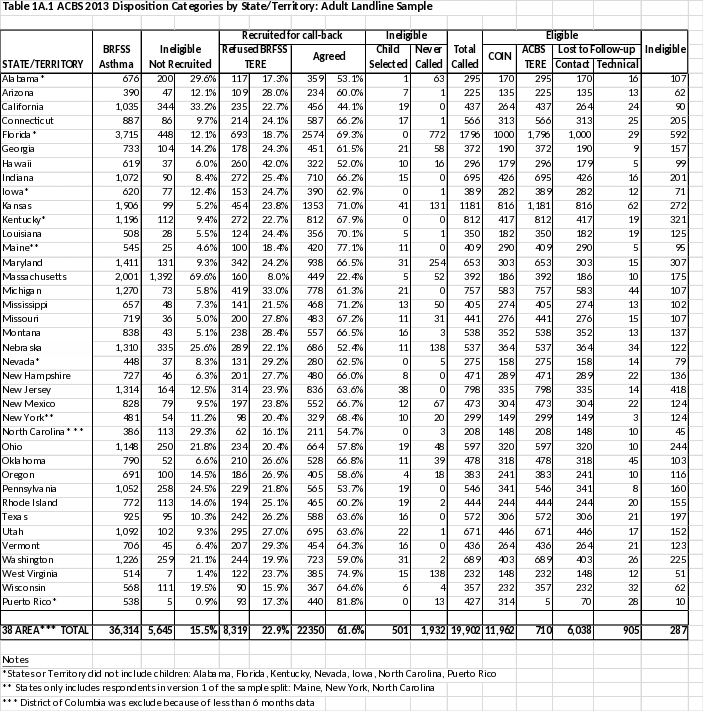
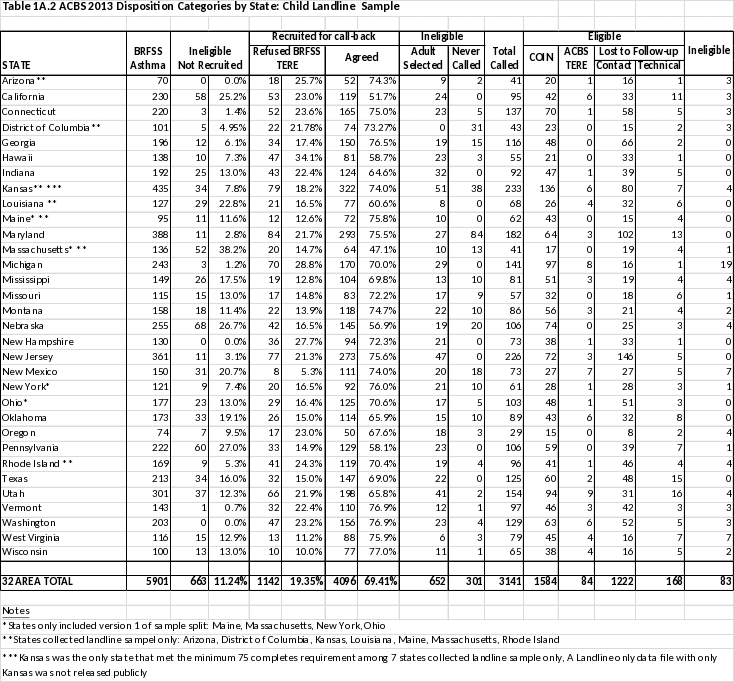
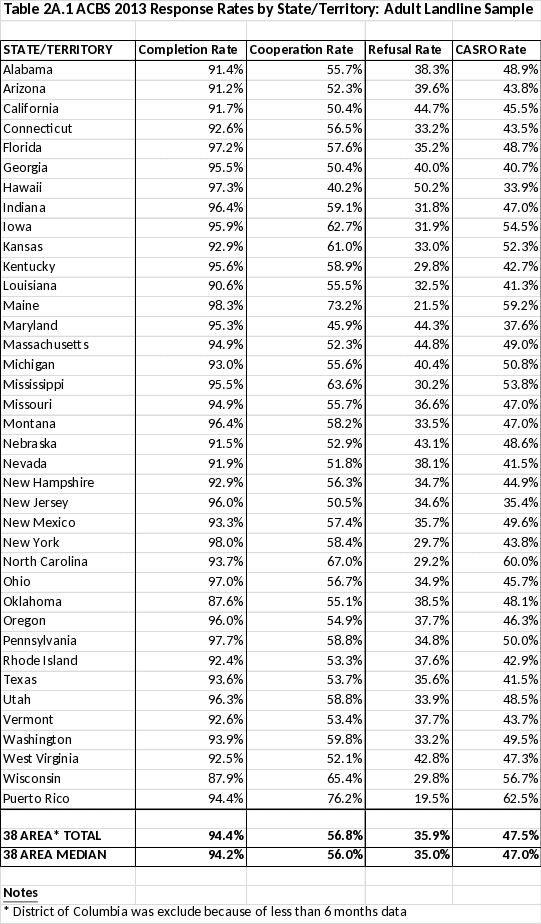
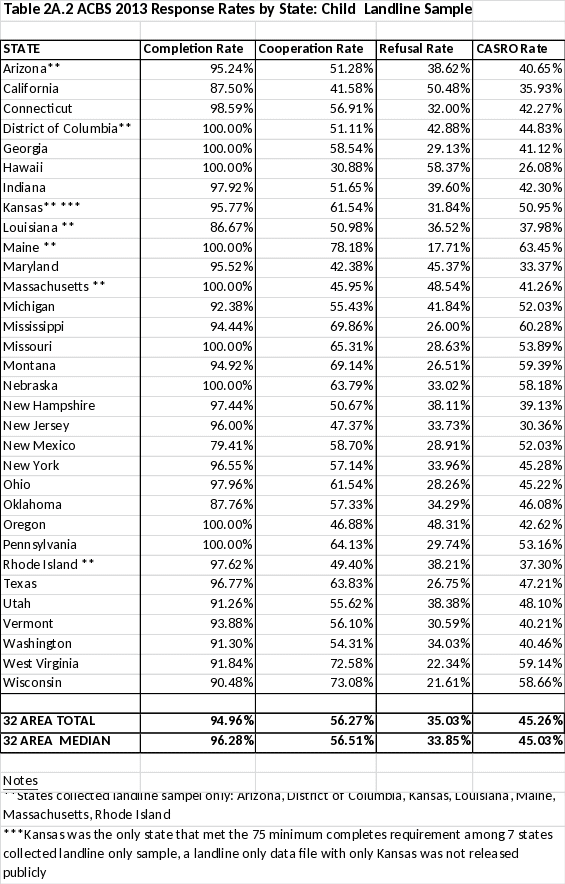
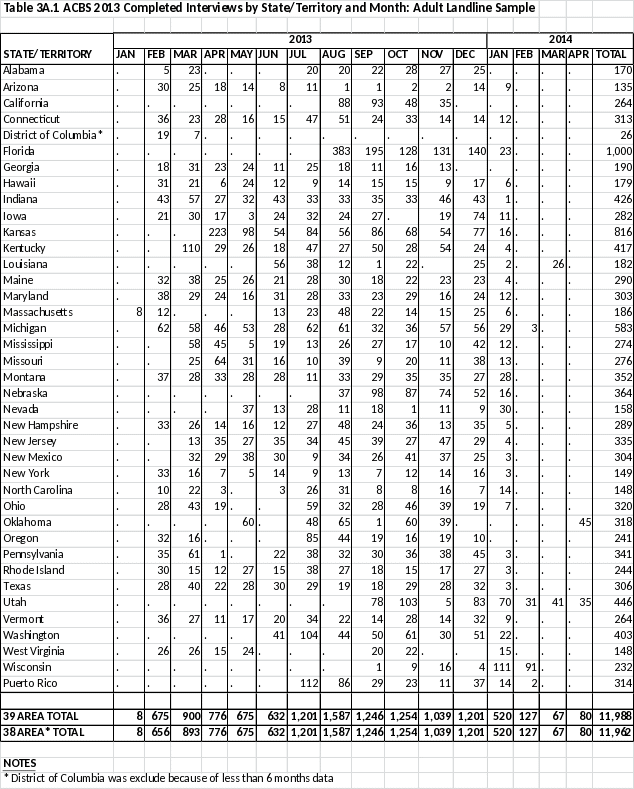
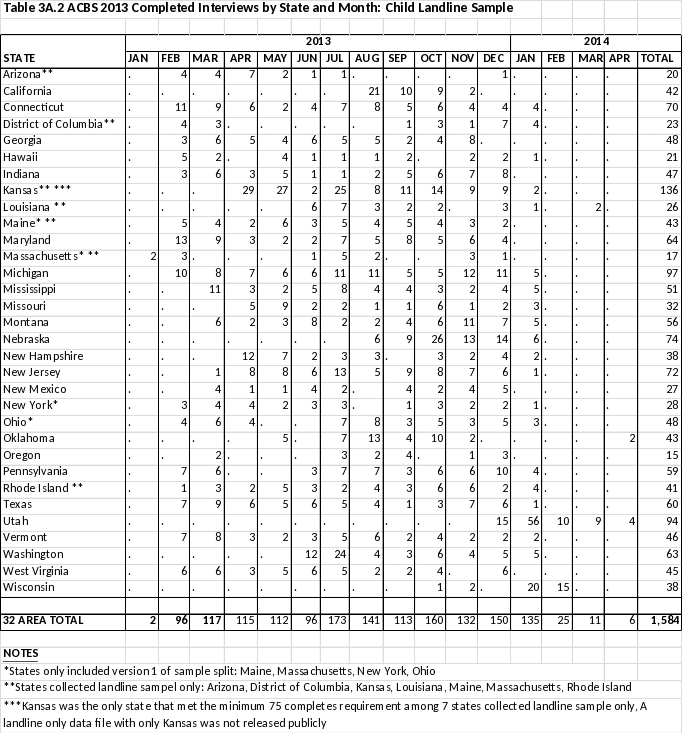
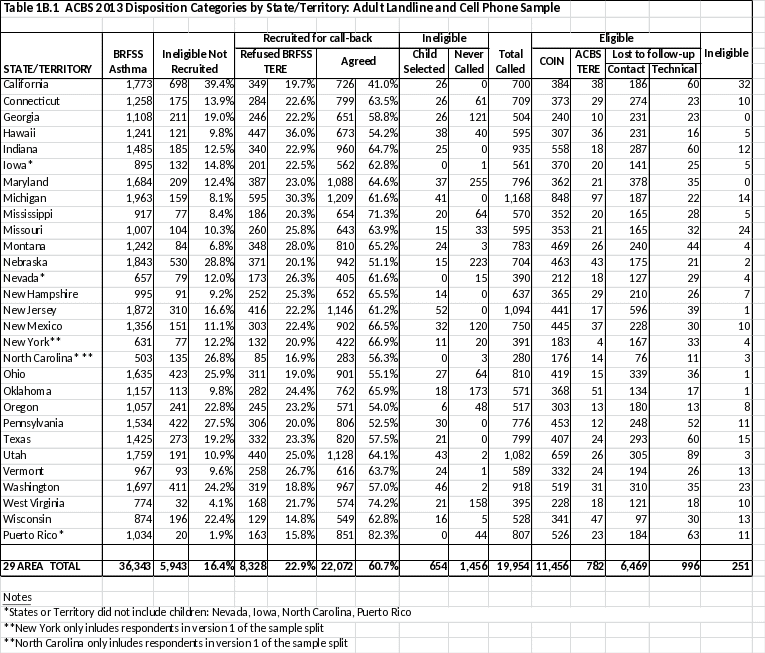
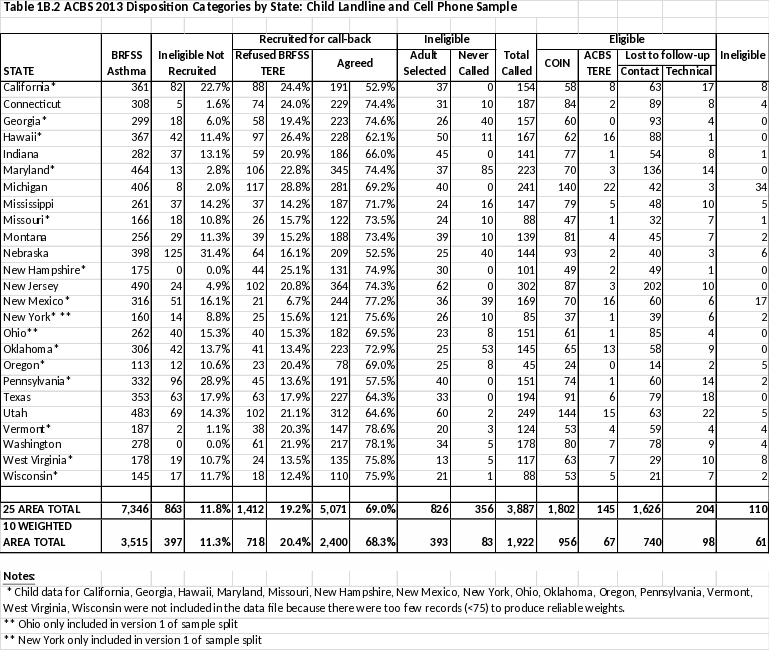
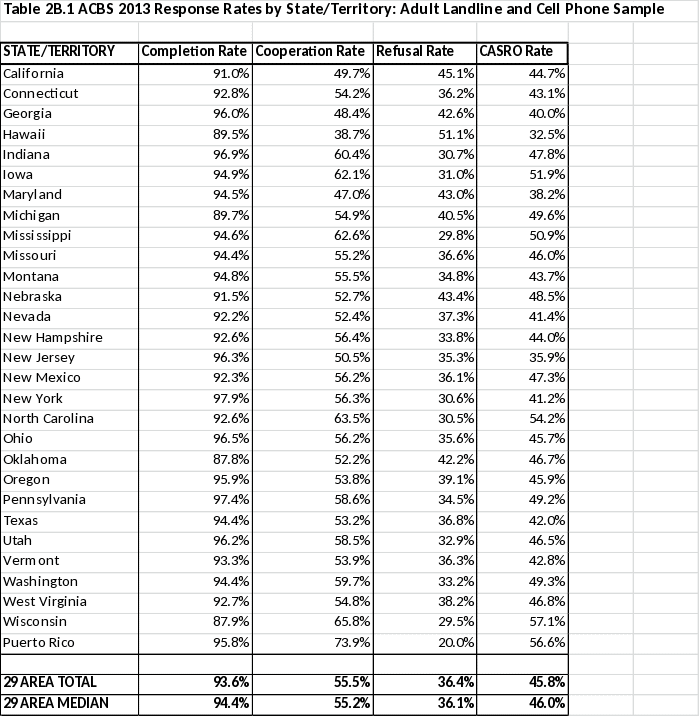

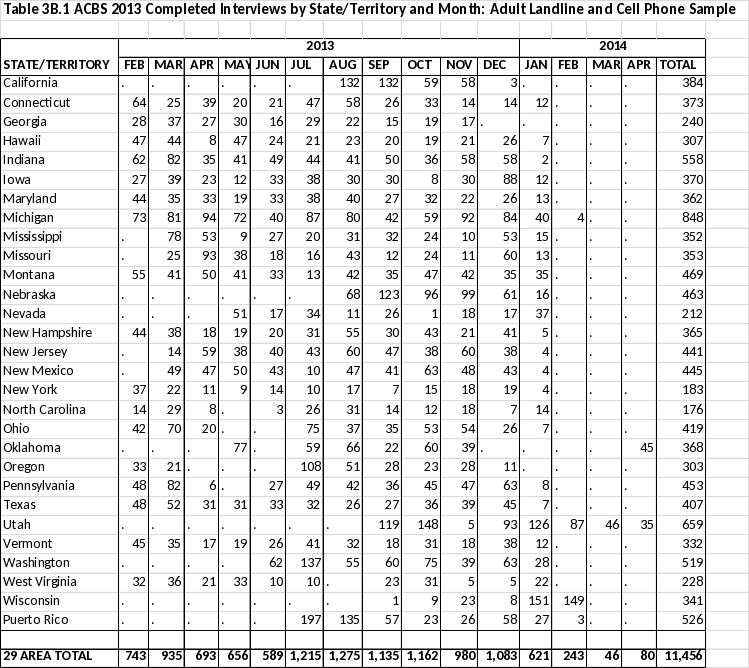
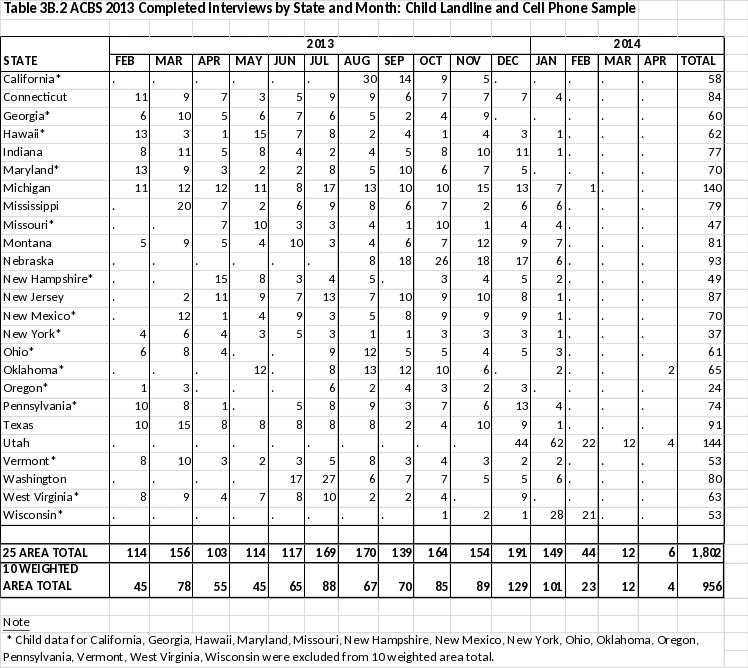
Appendix B: Conversion to 4-digit from 3-digit ACBS disposition codes
I. Eligible, contacted: complete interview
1100 110 Complete
1200 120 Partial complete (break-off after the end of section 8)
II. Eligible, contacted: refusal or termination
4413 413 Refused to participate in the call-back during the BRFSS interview
2112 220 Refused to begin the ACBS interview after contacted
2120 210 Terminated within the questionnaire (before section 9 of the ACBS interview)
2211 211 Refused to allow combining ACBS responses with BRFSS responses
2212 212 Refused to answer the “ever had asthma” question during the ACBS interview
III. Eligible, lost to follow-up because unable to contact or communicate with the BRFSS respondent
2111 270 Hang up or termination before ACBS respondent contacted
2111 280 Household contact after number of adults recorded but before ACBS respondent contacted
2210 230 Selected respondent never reached or reached but did not begin interview during interviewing period
2210 240 Selected respondent away from residence during the entire interviewing period
2220 335 Telephone answering device, message confirming private residential status
2220 340 Telecommunication technological barrier, message confirming private residential status
2320 260 Selected respondent physically or mentally unable to complete an interview during the entire interviewing period
2330 250 Language problem after respondent selection
3100 330 Hang-up or termination, unknown if private residence
3100 332 Contact, unknown if private residence
3130 360 No answer
3140 345 Telephone answering device, unknown if private residence
3200 310 Hang-up or termination, known household
3200 315 Household contact, eligibility undetermined
3322 325 Physical or mental impairment
3330 320 Language problem
4100 305 Household members away from residence during entire interviewing period
4900 N/A No previous 3-digit code
4306 306 Selected ACBS respondent no longer living in the BRFSS household
5050 505 Refusal: hang-up, unknown if housing unit
5100 510 Call-back appointment
5111 505 Refusal: household level refusal
5112 505 Refusal: respondent refusal, hang-up, or termination
5120 505 Refusal: hang-up or termination before starting section 9
5130 550 No answer
5140 535 Answering machine, unknown if private residence
5220 525 Answering machine, message confirming residential status
5320 520 Physical or mental impairment
5330 515 Language problem
5550 555 Busy
5560 N/A Unsafe location for interview
IV. Eligible, lost to follow-up for technical reasons
3150 350 Telecommunication technological barrier, unknown if private residence
3700 370 On never call list
4200 430 Dedicated fax/data/modem line with no human contact
4300 355 Telephone number no longer in service or changed
4300 450 Non-working/disconnected number
4400 365 Busy
4400 440 Fast busy
4430 N/A Call forwarding/pager
4450 435 Cellular telephone
4460 N/A Cell phone number connects to landline
4470 N/A Landline number connects to cell phone
4500 420 Not a private residence
4510 420 Not a private residence
5150 540 Technological barrier other than answering machine, unknown if private residence
5200 560 Fax/data/modem
5300 545 Phone number temporarily out of service
5300 570 Possible non-working number
5400 530 Technological barrier other than answering machine, message confirming residential status
5550 555 Busy
5599 599 Mistaken Ctrl-end
5700 580 Requires supervisor attention
5900 585 Null attempt
5999 N/A Missing disposition code
V. Ineligible
2290 290 Most Knowledgeable Person isn't parent or legal guardian (child)
2291 291 No parent or legal guardian in the household (child ineligible)
4480 480 Not recruited for call-back at BRFSS interview (excluded by state)
4490 490 Random child/adult selection: adult ineligible, child selected
4491 491 Random child/adult selection: child ineligible, adult selected
4405 405 Out-of-state when ACBS records are not transferred to actual state of residence
4700 410 Household, no eligible respondent (respondent does not have asthma)
4411 411 Selected respondent not eligible for follow-up
4412 412 Transferred from BRFSS but not attempted (excluded by state)
4471 470 Misdiagnosed asthma in respondent (2008 and later)
Appendix C: Instructions for Assigning Additional ACBS Disposition Codes
Following are descriptions of the ACBS disposition codes adapted from standard BRFSS disposition codes and the ACBS disposition codes added to the standard set of BRFSS disposition codes. For detailed definitions for the standard BRFSS disposition codes see the Data Quality Handbook for each survey year (http://www.cdc.gov/brfss/annual_data/annual_data.htm).
I. Eligible, contacted: complete interview
1100 Complete
Definition: Respondent completes the ACBS interview through the last question.
1200 Partial complete
Definition: Respondent completes the ACBS interview at least through the end of Section 8 (medications).
II. Eligible, contacted: refusal
4413 Refused to participate in the call-back during the BRFSS interview
Definition: During the BRFSS interview, respondents who indicate they have ever been told by a doctor that they have asthma are asked if they will participate in an additional survey at a later date. Some state Institutional Review Boards (IRBs) require that the content of the additional survey (asthma) be disclosed; other state IRBs require that the specific content not be disclosed. Some states have multiple call-back surveys in the field and do not specify the content of any of the call-back interviews. If a respondent refuses to participate in the call-back survey, that record is assigned disposition code 9413.
2112 Refused to begin the ACBS interview after contacted
Definition: If the selected respondent is contacted for the ACBS interview but refuses to begin the interview, then the record is assigned code 9220.
2120 Terminated within the questionnaire during the ACBS interview
Definition: If the respondent is contacted for the ACBS and terminates after the interview begins (section 3) but before completing section 8, then record is considered incomplete and is assigned disposition code 9210.
2211 Refused to allow combining ACBS responses with BRFSS responses
Definition: Some states require that the respondent provide active approval to combine their responses from the initial BRFSS interview with their responses from the ACBS interview. This approval may be requested at either the initial BRFSS interview or at the beginning of the ACBS interview. If the respondent does not approve combining data from the two interviews, the record is assigned disposition code 9211.
2212 Refused to answer the “ever had asthma” question during the ACBS interview
Definition: The selected respondent is contacted for the ACBS interview but refuses to answer the initial asthma question. If the respondent answers "don't know" or "refused" to the ACBS question EVER-ASTH (2.1) “Have you ever been told by a doctor or other health professional that (you have/sample child has) asthma?”, then the record is assigned code 9212.
III. Eligible, lost to follow-up because unable to contact or communicate with the BRFSS respondent
4306 Selected ACBS respondent no longer living in the BRFSS household
Definition: The BRFSS respondent with asthma left the BRFSS household between the BRFSS interview and the ACBS interview. If the selected respondent (from the BRFSS) no longer lives in the BRFSS household but did live in the household during the BRFSS interview, then attempts should be made to obtain new contact information for the selected respondent, and the follow-up should be conducted using the new telephone number. If this is not possible or the household refuses to provide new contact information, then the record is assigned disposition code 9306.
Refer to the Data Quality Handbook for each survey year for the definitions of all other codes in this category (http://www.cdc.gov/brfss/technical_infodata/surveydata.htm).
IV. Eligible, lost to follow-up for technical reasons
Refer to the Data Quality Handbook for each survey year for the definitions of all codes in this category (http://www.cdc.gov/brfss/technical_infodata/surveydata.htm).
V. Ineligible
2290 The person the most knowledgeable about the selected child with asthma is not the parent or legal guardian (child ineligible)
Definition: This code applies only to the child ACBS interview. The child selected during the BRFSS interview is eligible for the ACBS (the BRFSS respondent indicated that the selected child has an asthma diagnosis). The ACBS child protocol allows a parent or guardian to transfer the interview to a more knowledgeable proxy respondent. If the BRFSS respondent is not the parent or guardian of the selected child with asthma, but the parent or guardian is present to transfer to the person most knowledgeable about the child’s heath, but the most knowledgeable person is not available, then the child is ineligible for the ACBS. The child record is assigned disposition code 2290
2291 No parent or legal guardian in the household (child ineligible)
Definition: This code applies only to the child ACBS interview. The child selected during the BRFSS interview is eligible for the ACBS (the BRFSS respondent indicated that the selected child has an asthma diagnosis). However, ACBS child protocol requires that the BRFSS respondent must be the parent or guardian of the child to provide proxy responses for the child or to approve transfer to a more knowledgeable proxy respondent. If there is no parent or guardian of the selected child with asthma in the household, the child is ineligible for the ACBS. The child record is assigned disposition code 2291.
4405 Out-of-state
Definition: The BRFSS question that determines eligibility for the ACBS is “Have you ever been told by a doctor, nurse, or other health professional that (you have/the sample child has) asthma?” Respondents who answer “yes” are eligible for the ACBS. If the respondent is a state resident at the time of the BRFSS interview, but moves to an out-of-state residence between the BRFSS interview and the ACBS interview, the respondent is not eligible for the ACBS if either the new state or the old state is not participating in record transfers, and the record is assigned disposition code 4405.
4700 Household, no eligible respondent (respondent does not have asthma)
Definition: The BRFSS question that determines eligibility for the ACBS is “Have you ever been told by a doctor, nurse, or other health professional that (you have/the sample child has) asthma?” Respondents who answer “yes” are eligible for the ACBS. If the respondent informs the ACBS interviewer that the recorded response from the BRFSS interview was in error and terminates the call, then the respondent is not eligible for the ACBS, and the record is assigned disposition code 4700.
4411 Selected respondent not eligible for follow-up
Definition: If the respondent disagrees with the recorded response to the asthma question from the BRFSS interview and answers “no” to the ACBS question EVER-ASTH (2.1) “Have you ever been told by a doctor or other health professional that (you have/the sample child has) asthma?”, then the respondent is not eligible for the ACBS, and the record is assigned disposition code 4411.
4412 Transferred from BRFSS but not attempted (excluded by state)
Definition: The BRFSS question that determines eligibility for the ACBS is “Have you ever been told by a doctor, nurse, or other health professional that (you have/the sample child has) asthma?” Respondents who answer “yes” are eligible for the ACBS. Eligible respondents are then asked for permission to call back. Those that agree should be called for the ACBS interview. However, if a respondent eligible to be called is transferred from BRFSS to the ACBS but never called, then the record is assigned disposition code 4412.
4471 Misdiagnosed asthma in respondent (2008 and later)
Definition: The BRFSS question that determines eligibility for the ACBS is “Have you ever been told by a doctor, nurse, or other health professional that (you have/the sample child has) asthma?” Respondents who answer “yes” are eligible for the ACBS. However, the initial diagnosis could have been in error and changed. This misdiagnosis is not captured by the BRFSS or ACBS. If the respondent informs the interviewer of the misdiagnosis, the respondent is not eligible for the ACBS, and the record is assigned disposition code 4470.
4480 Not recruited for call-back at BRFSS interview (excluded by state)
Definition: The BRFSS question that determines eligibility for the ACBS is “Have you ever been told by a doctor, nurse, or other health professional that (you have/the sample child has) asthma?” Respondents who answer “yes” are eligible for the ACBS. Eligible respondents are then asked for permission to call back. Those who agree should be called for the ACBS interview. However, if a respondent eligible to be called is not transferred from BRFSS to the ACBS and is never called, then the record is assigned disposition code 4480.
4490 Random child/adult selection: adult ineligible, child selected
Definition: If both the BRFSS respondent and the randomly selected child in the household have asthma and the BRFSS respondent agrees to the call-back interview, one or the other is randomly selected to be eligible for the call-back. If the child is selected, the adult is ineligible, and the adult record is assigned disposition code 4490.
4491 Random child/adult selection: child ineligible, adult selected
Definition: If both the BRFSS respondent and the randomly selected child in the household have asthma and the BRFSS respondent agrees to the call-back interview, one or the other is randomly selected to be eligible for the call-back. If the adult is selected, the child is ineligible, and the child record is assigned disposition code 4491.
| File Type | application/vnd.openxmlformats-officedocument.wordprocessingml.document |
| File Title | 2006-2008 Behavioral Risk Factor Surveillance System Asthma Call-Back Survey Summary Data Quality Report |
| Subject | 2006-2008 Behavioral Risk Factor Surveillance System Asthma Call-Back Survey Summary Data Quality Report |
| Author | CDC |
| File Modified | 0000-00-00 |
| File Created | 2021-01-21 |
© 2025 OMB.report | Privacy Policy